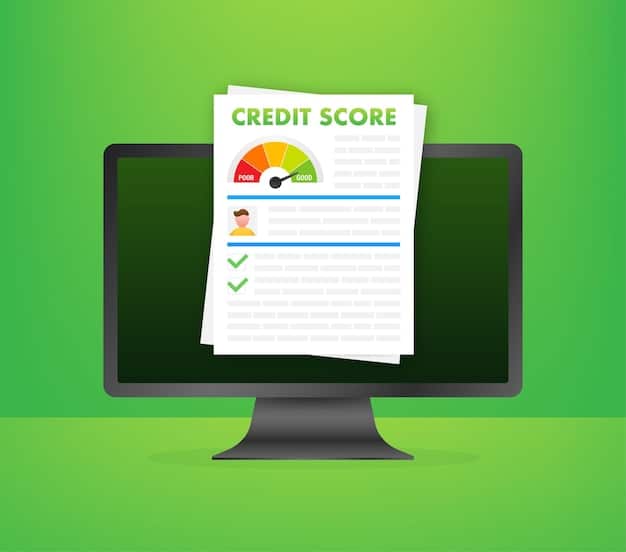Credit Score Repair: A Complete 6-Month Guide to Improving Your Creditworthiness

Credit score repair is a process of addressing inaccuracies and negative items on your credit reports to improve your creditworthiness, often achievable within six months through diligent monitoring, disputing errors, and adopting responsible financial habits.
Want to boost your credit score but feel overwhelmed? This is your comprehensive guide to **credit score repair: improving your creditworthiness in 6 months**. We’ll break down the process into actionable steps, helping you understand how credit scores work and what you can do to achieve a better financial future.
Understanding Your Credit Score
Before diving into the repair process, it’s crucial to understand what a credit score is and why it matters. Your credit score is a three-digit number that represents your creditworthiness. Lenders use this score to assess the risk of lending you money.
A good credit score can unlock better interest rates on loans, credit cards, and even insurance. It can also affect your ability to rent an apartment or secure a job. Several factors influence your credit score, with payment history and amounts owed being the most significant.

Key Factors Affecting Your Credit Score
- Payment History: Making on-time payments is the most critical factor.
- Amounts Owed: Keeping your credit utilization ratio (the amount of credit you’re using compared to your total available credit) low is essential.
- Length of Credit History: A longer credit history generally leads to a higher score.
- Credit Mix: Having a mix of different types of credit (e.g., credit cards, installment loans) can be beneficial.
- New Credit: Opening too many new accounts in a short period can negatively impact your score.
Understanding these factors empowers you to make informed decisions that positively impact your credit score. Monitoring your score regularly helps you track your progress and identify any potential issues.
In conclusion, understanding the components of your credit score is the foundational step toward effective credit repair. Knowing what affects your score will empower you to make informed decisions and implement strategies to improve it.
Obtaining Your Credit Reports
The first step in **credit score repair: improving your creditworthiness in 6 months** is to obtain copies of your credit reports from all three major credit bureaus: Experian, Equifax, and TransUnion. These reports contain detailed information about your credit history, including your payment history, credit accounts, and public records.
You can obtain free copies of your credit reports annually from AnnualCreditReport.com. This is a government-authorized website that allows you to access your reports without charge. Reviewing these reports is crucial to identify inaccuracies and negative items that may be dragging down your score.
How to Access Your Credit Reports
- Visit AnnualCreditReport.com: This is the official website for obtaining free credit reports.
- Provide Required Information: You’ll need to provide your name, address, Social Security number, and date of birth.
- Review Each Report Carefully: Look for any errors, inaccuracies, or outdated information.
Different credit bureaus may have slightly different information on your reports, which is why it’s essential to check all three. Common errors include incorrect payment dates, accounts that don’t belong to you, and outdated information.
By identifying and addressing these errors, you can begin the process of repairing your credit score and improving your overall creditworthiness.
In summary, obtaining and carefully reviewing your credit reports from all three major credit bureaus is a critical initial step. This process allows you to pinpoint inaccuracies and negative items that need to be addressed in your credit repair journey.
Identifying Errors and Negative Items
Once you have your credit reports in hand, the next step is to carefully scrutinize them for any errors or negative items. These could be inaccuracies such as accounts that don’t belong to you, incorrect payment dates, or accounts listed more than once.
Negative items can include late payments, collections, charge-offs, and bankruptcies. Identifying these issues is crucial for taking targeted action to improve your credit score.
Common Errors to Look For
- Incorrect Personal Information: Check for misspelled names, incorrect addresses, or wrong Social Security numbers.
- Accounts That Don’t Belong to You: Look for accounts that you never opened or authorized.
- Incorrect Payment History: Verify that your payment dates are accurate and that no payments are incorrectly listed as late.
When reviewing your credit reports, it’s beneficial to highlight any discrepancies or negative items that you believe are inaccurate or outdated. Make a list of these items for further action.

Inaccuracies and negative items can significantly impact your credit score. Taking the time to identify and address these issues is a crucial step in the **credit score repair: improving your creditworthiness in 6 months** process. A diligent review sets the stage for disputing errors and implementing strategies to boost your creditworthiness.
In conclusion, thoroughly examining your credit reports for inaccuracies and negative items is a necessary step in credit repair. This careful review allows you to pinpoint discrepancies and prepare for the dispute process effectively.
Disputing Credit Report Errors
After identifying errors on your credit reports, it’s time to dispute them with the credit bureaus. This involves sending a formal dispute letter to each bureau, detailing the specific errors and providing supporting documentation.
The credit bureaus are legally required to investigate your disputes within 30 days. If they find that the information is indeed inaccurate, they must correct or delete it from your credit report.
Writing an Effective Dispute Letter
- Be Clear and Concise: State the specific errors you are disputing and why you believe they are inaccurate.
- Include Supporting Documentation: Provide copies of any documents that support your claim, such as payment records, account statements, or identity verification.
- Send Your Dispute via Certified Mail: This provides proof that the credit bureau received your letter.
Remember to send a separate dispute letter to each credit bureau, as they may not share information with each other. Keep copies of all correspondence for your records.
The dispute process can take time, so be patient. If the credit bureau does not respond within 30 days or refuses to correct the error, you have the right to file a complaint with the Consumer Financial Protection Bureau (CFPB).
By disputing inaccuracies, you can remove negative items from your credit report and improve your credit score. This is a crucial component of **credit score repair: improving your creditworthiness in 6 months**.
In summary, disputing errors on your credit reports is a pivotal step in repairing your credit. By sending well-documented dispute letters and following up diligently, you can effectively correct inaccuracies and improve your credit score over time.
Negotiating with Creditors and Collection Agencies
In addition to disputing errors, you can also negotiate with creditors and collection agencies to potentially remove negative items from your credit report. This can be particularly helpful if you have outstanding debts that are affecting your credit score.
One common negotiation strategy is to offer a “pay-for-delete” agreement, where you agree to pay a portion of the debt in exchange for the creditor or collection agency removing the negative item from your credit report. However, it’s important to get this agreement in writing before making any payments, as there’s no guarantee that they’ll honor the agreement otherwise.
Strategies for Negotiating
- Offer a Partial Payment: Propose to pay a percentage of the debt in exchange for deletion of the negative item.
- Obtain a Written Agreement: Always get the pay-for-delete agreement in writing before making any payments.
- Be Polite and Professional: Maintain a respectful tone throughout the negotiation process.
Another strategy is to negotiate a payment plan with creditors if you’re struggling to keep up with your payments. This can help you avoid further late payments and potential negative impacts on your credit score.
Negotiating with creditors and collection agencies can be a complex process, so it’s important to do your research and understand your rights. Consider seeking advice from a credit counselor or financial advisor if you’re unsure how to proceed.
In conclusion, negotiating with creditors and collection agencies offers a practical way to improve your credit report by removing negative entries. By employing effective negotiation strategies and securing written agreements, you can positively influence your credit score and overall financial standing.
Building Positive Credit Habits
While disputing errors and negotiating with creditors are important steps in credit repair, they are not enough on their own. To truly improve your creditworthiness, you need to build positive credit habits that will sustain your credit score over the long term. The most crucial factor here involves creating better positive credit habits to establish a pattern of responsible credit usage.
This includes making on-time payments, keeping your credit utilization ratio low, and avoiding unnecessary debt. It also means being mindful of your spending habits and creating a budget to stay on track.
Essential Positive Credit Habits
- Make On-Time Payments: Set up automatic payments or reminders to ensure you never miss a due date.
- Keep Credit Utilization Low: Aim to use no more than 30% of your available credit on each card.
- Avoid Unnecessary Debt: Only borrow what you can realistically afford to repay.
Consider opening a secured credit card if you have a limited or damaged credit history. These cards require a security deposit, but they can help you build credit by reporting your payment activity to the credit bureaus.
Building positive credit habits is an ongoing process, but it’s essential for achieving and maintaining a healthy credit score. Focus on responsible financial behavior, and your credit score will gradually improve over time.
In essence, cultivating positive credit habits such as consistent on-time payments and maintaining low credit utilization is vital for achieving and sustaining a healthy credit score over time. These responsible practices lay the foundation for long-term creditworthiness.
| Key Point | Brief Description |
|---|---|
| 🔍 Credit Reports | Obtain and review them for errors and negative items. |
| ✍ Dispute Errors | Send formal dispute letters to credit bureaus. |
| 💰 Negotiation | Negotiate with creditors for pay-for-delete agreements. |
| ✅ Positive Habits | Build habits like on-time payments and low credit utilization. |
FAQ
▼
The timeframe varies, but noticeable improvements often occur within six months with consistent effort. Significant changes may take longer, depending on the severity and number of negative items.
▼
If the credit bureau doesn’t correct the error, you can file a complaint with the Consumer Financial Protection Bureau (CFPB) and consider seeking legal advice.
▼
Yes, but be cautious. Ensure they are reputable and understand your rights. You can achieve the same results yourself by following the steps in this guide.
▼
Credit utilization is critical. Keeping it below 30% demonstrates responsible credit management and positively impacts your credit score.
▼
A secured credit card requires a security deposit, while an unsecured card doesn’t. Secured cards are helpful for building credit if you have a limited or damaged credit history.
Conclusion
Repairing your credit score is a journey that requires patience, diligence, and a commitment to responsible financial habits. By following these steps consistently, you can improve your creditworthiness and achieve your financial goals.





